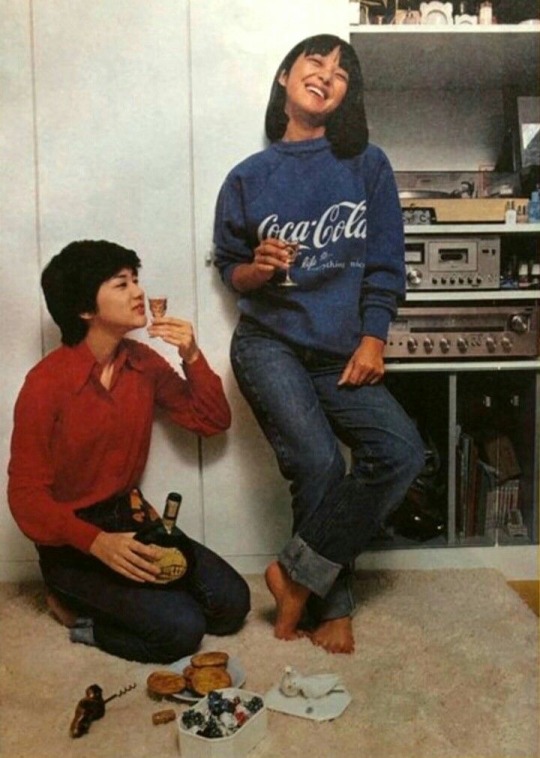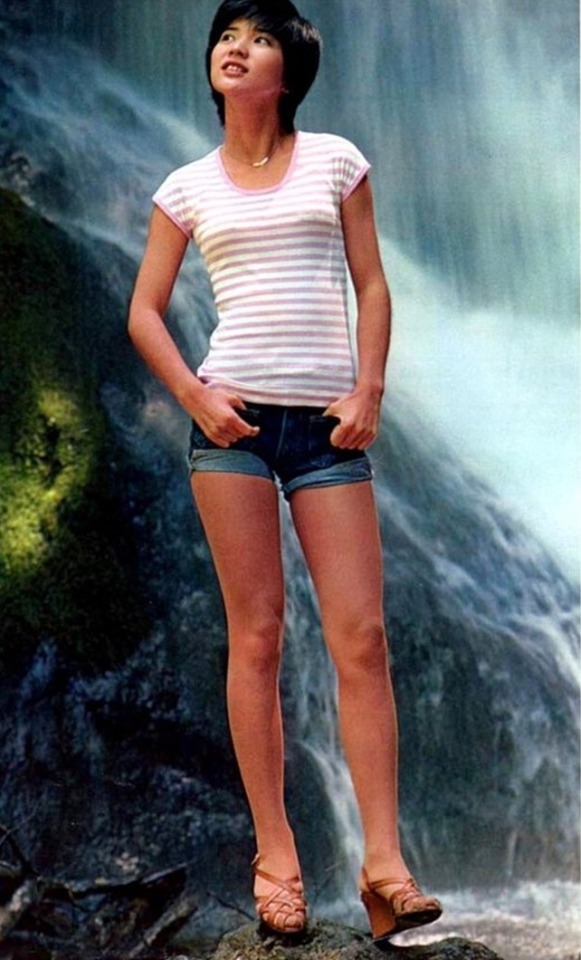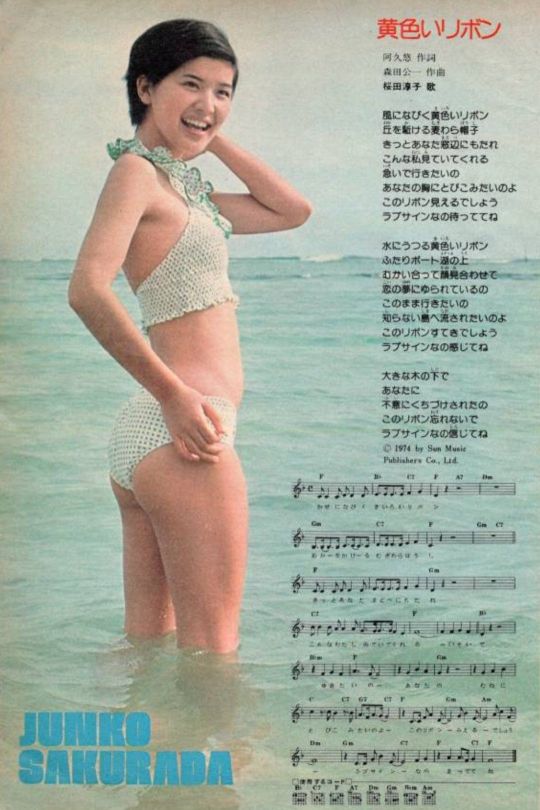#junko sakurada
Video
youtube
21 notes
·
View notes
Text

Artist - 桜田淳子 (Sakurada, Junko)
Song - もう一度だけふり向いて (Mō Ichido Dake Furimuite)
[Eng. "Turn Around Just Once More"]
Release Date - December 1976
Listen 🎶
My blog: Showa Music Library
https://nobbykun.tumblr.com/
5 notes
·
View notes
Text
70s Japan Trends Through the Music Charts (Part 2)
During the 1970s, the Japanese music industry was in the process of forming its identity. In addition to mirroring the musical preferences of the nation, the charts also served as a reflection of the prevailing societal trends and ambitions of that era. In this series, we chronicle the most significant musical trends of the decade.
70s Japan Trend Through the Music Charts (Part 1)
Trend #4: The Impact of Discover Japan
In 1970, Osaka hosted the World Expo, marking a significant milestone for post-war Japan following the 1964 Tokyo Olympics. To accommodate the influx of visitors, the government expanded the rail network, enabling over 60 million people—half of the nation's population—to journey to the World's Fair. However, as the Expo drew to a close after six months, concerns arose about the railways becoming obsolete. So, with the help of the ad agency Dentsu, they devised a campaign to stimulate domestic tourism by rail. The result was "DISCOVER JAPAN," one of the most iconic campaigns of the decade (which, curiously, was partially inspired by Ivy Fashion brand VAN).
"DISCOVER JAPAN" profoundly impacted Japanese society by popularizing solo travel and igniting domestic tourism, particularly among young women who ventured out on their own. This trend was further fueled by the launch of the first female fashion magazines, AnAn and Non-no, both of which extensively covered visits to charming cities across the country. Cities known as "Little Kyoto," which retained their Edo Period architecture and charm, were particularly attractive to these travelers.
Influenced by fashion magazines, these trend-conscious women journeyed to towns throughout Japan, earning them the moniker "AnNon" (a fusion of AnAn and Non-no). Their impact during the 1970s was significant enough to be mentioned in a song by Sada Masashi, one of the decade's prominent folk singers.

"DISCOVER JAPAN," the print and TV campaign devised by Dentsu, is one of Japan's most successful and era-defining marketing campaigns.
Sada Masashi rose to fame in the early 1970s as part of the folk duo Grape before launching a successful solo career. In 1977, his song "Ehagakizaka," which paid tribute to his hometown of Nagasaki, mentioned identically dressed stylish young girls in denim, clutching AnAn and Non-no magazines while photographing their surroundings. This song vividly captured the aspirational girl culture of the 1970s, characterized by "healing" domestic trips in pursuit of tranquility and small pleasures, hippie and boho-inspired fashion, and folk music as the soundtrack.
Masashi Sada's song and the AnNon-zoku tribe aside, "DISCOVER JAPAN," had an immense impact on different layers of Japanese society. And that included the music charts. In 1971, the two best-selling singles, "Watashi no joka-machi" by Rumiko Koyanagi and "Shiretoko ryojou" by Tokiko Kato, surpassed 1 million copies sold. Both perfectly embodied the campaign's spirit in highlighting the hidden beauties of Japan.
"Watashi no jokamachi," or "My Castle Town," marked Koyanagi's explosive debut, selling over 1.3 million copies. This enka-infused kayokyoku ballad paid homage to cities with Edo-like architecture, often centered around a feudal lord's castle, evoking a peaceful, melancholic atmosphere in its lyrics. Rumiko continued to sing about regional Japan's charms the following year with another hit, "Seto no Hanayome" (The Bride of Seto). Meanwhile, the folk-inspired "Shiretoko ryoujou" (Shiretoko Journey) celebrated the unique beauty and culture of the Shiretoko peninsula on Hokkaido Island.
In the same year, other artists also succeeded by spotlighting provincial Japan. Enka superstar Shinichi Mori delved into this theme with "Boukyou" (Nostalgia). At the same time, Yuuko Nagisa found success with a Japanese rendition of The Ventures' "Kyoto Doll," titled "Kyoto no Koi" (Love in Kyoto). She would go on to have another top-selling single with her version of another Ventures song, "Reflection in Palace Lake," transformed into "Kyoto Bojo" (Kyoto Longing).
Trend #5: The Legend of Momoe Yamaguchi
"Aidoru" or "idols" are cute girl/boy-next-door types who sing, dance, act, host TV shows, and star in countless commercials. They stand as one of the cornerstones of the thriving multi-billion yen Japanese entertainment industry. The 70s was an essential era for consolidating this type of star. And one idol, in particular, shone the brightest: Momoe Yamaguchi.
Momoe is a legendary star and an example of an "aidoru" who excelled at everything, exuding sophistication, talent, and sex appeal. The fact she retired from public life at the height of her fame cemented her mythical status.

Momoe Yamaguchi in her prime, the idol industry's gold standard.
In 1972, at the tender age of 13, Yamaguchi auditioned for the talent search TV show "Star Tanjou!" (A Star is Born). Her crisp singing voice and mature beauty immediately captured the industry's attention. Hori Production, the entertainment agency, and Sony CBS label swiftly recognized her potential and signed her. In May 1973, five months after her televised audition, she made her official debut with the single "Toshigoro" (Adolescence). Although Sony had a history of immediate success with newcomers, Momoe's first single received a tepid response, so her label decided to court a bit of controversy for her sophomore outing. "Aoi kajitsu" (Ripe Fruit) had the innocent-looking 14-year-old girl singing, "you can do whatever you want to me, even if they say I'm a bad girl." The racy lyrics worked, and the single was a success.
A few months later, Yamaguchi's backers repeated this formula with "Hito natsu no keiken" (One Summer Experience). The song began with a suggestive promise: "I'll give you the most precious thing a girl has." The lyrics were laden with double entendres, describing a "sweet trap of temptation" that can only be experienced once. She sang, "if the person I love is pleased, then I'm happy. I don't mind if you break it," which could be understood as a reference to a girl's heart or hymen.
The single was an explosive hit, propelling 15-year-old Yamaguchi into the A-list. For the remainder of her career, she was frequently asked about the "most precious thing a girl has," to which she'd always offer a stern-looking reply: "Her devotion."
The young, mature-looking girl singing thinly veiled songs about sexual awakening with a dark, serious-looking image set her apart from the prevalent happy-go-lucky idol aesthetic. However, it wasn't merely reliance on gimmicks that transformed her into a legend. In 1976, after firmly establishing herself as a star, she parted ways with her frequent collaborators, lyricist Kazuya Senke and composer Shunichi Tokura. Beginning with the single "Yokosuka Story," she partnered with the husband-and-wife duo Yoko Aki and Ryudo Uzaki.
Ryudo Uzaki, the frontman of the popular enka rock band DOWNTOWN BOOGIE WOOGIE BAND, infused her kayokyoku tunes with a rock edge. Through her lyrics, Yoko Aki redefined Momoe's image as a confident, clear-eyed girl transitioning into womanhood. Sony initially opposed Momoe's desire to collaborate with Aki and Uzaki, but the partnership ultimately helped her reach her commercial peak.
"Yokosuka Story" was Momoe's first single to reach the number 1 spot on the weekly charts. The Aki-Uzaki duo penned several other hits for her, including "Playback Part 2" and "Sayonara no mukougawa" (The Other Side of Goodbye), and opened doors for her to collaborate with other luminaries of Japanese music. Two of her most memorable hits, "Cosmos" and "Ii hi tabidaichi" (Beautiful Day Departure), both released in 1978, were penned by folk superstars Masashi Sada and Shinji Tanimura of Arisu, respectively. The latter became the theme song for the iconic DISCOVER JAPAN TV commercials.
Speaking of commercials, idols worth their salt can't limit themselves to music. Momoe earned millions as the face of Toyota cars, Fujifilm photographic films, Casio watches, and Glico confectionary products, among others. She also starred in highly rated TV dramas and ventured into the world of film.
Starting in 1974, she appeared in two romantic films per year, always paired with Tomokaza Miura as her co-star. While Momoe pursued various ventures, Miura's acting career primarily revolved around being her on-screen romantic partner. Their undeniable chemistry and the box-office success of their films led to them being known as the "golden combination."
In a concert at the end of 1979, Momoe stunned her audience by revealing that her on-screen partner, Miura, was her real-life boyfriend. In a subsequent press conference in March of the following year, she confirmed her intention to marry him and retire officially. In September, she released her autobiography, which sold over 1 million copies in a month. In October, she bid farewell through a series of TV specials and a concert at Nippon Budokan. Her farewell concert reportedly earned Hori Productions over 20 million dollars, according to figures provided by the agency to Billboard magazine at the time. Momoe's success allowed HoriPro to become one of the best-established entertainment agencies in Japan, a position it still holds today. Her final performance took place at HoriPro's 20th-anniversary event, where she sang "Ii hi tabidaichi." In November, she married Miura and disappeared from the media.
The Japanese public obsession with her never waned. Paparazzi tried to capture her at her son's kindergarten graduation ceremony and doing classes at a local driving school. Many speculated she'd eventually come out of retirement. She never did, which only helped feed the obsession around her.
During the 1970s, Yamaguchi enjoyed immense success, but she was one of many popular female idols. The narrative created by her retirement elevated her to the status of a larger-than-life legend. She became the gifted, beautiful young woman who succeeded as a singer, a TV actress, and a movie star before choosing the ultimate happy ending: marriage. By choosing love, Momoe Yamaguchi, the legendary idol, transformed into an ordinary woman—a real-life fairy tale that resonated deeply with Japanese society.
Her decision was driven by profound motivations. Momoe revealed in her autobiography that she was raised by a single mother, the product of an extramarital affair. Her challenging upbringing and her father's late appearance to capitalize on her fame instilled a deep desire for a traditional, happy family life. She also grew weary of the relentless demands of stardom and the repetitiveness of performing the same songs. Thus, she made a heartfelt choice to relinquish fame and public life to give her husband the most important thing a girl has: her devotion.
Trend #6: Idols' Rise
The term "idol" in the Japanese entertainment industry finds its origins in the French film "Cherchez l'idole" (1963), which enjoyed immense popularity in Japan. Initially, "Aidoru" was used to describe the film's star, Sylvie Vartan, before it evolved into a general term to describe youthful-looking triple-threat domestic stars.
Before the coining of the term, "idol-like" stars had already existed. In the 1930s, Machiko Ashita attracted crowds to the Moulin Rouge Shinjuku and served as the face of several brands. In the 1950s, rockabilly stars enjoyed massive popularity among the youth, and the 1960s saw the rise of manufactured "group sound" bands and the female duo The Peanuts, comprised of twin sisters. Legendary stars such as Hibari Misora, Sayuri Yoshinaga, Teruhiko Saigo, Yukio Hashi, and Kazuo Funaki thrived as both movie stars and successful singers.
However, the 70s marked the consolidation of the "idol" aesthetic and career path, paving the way for the "golden era of idols" in the next decade. Essential for it to happen was the widespread adoption of the medium where idols shine the brightest: television.
TV allowed entertainment agencies to aggressively push their young, fresh-faced talents in front of a broad audience. They populated music and variety shows, commercials, and dramas. They were immaculate, life-sized stars ready to play the part of the nation's sweethearts.
Although history has crowned Momoe Yamaguchi as the ultimate 70s idol, she was just one among many during most of that decade. A closer examination of the numbers reveals that Mari Amachi, a female idol, had the most significant short-term impact during that time.
Amachi was first introduced on the popular TBS TV drama "Jikan desu yo" (It's Time) in 1971, playing "Tonari no Mari-chan" (Next Door Mari-chan). She played the minor role of a cute girl who lived close to the show's primary setting, a family-run public bathhouse, and often appeared by her window, playing guitar and singing. By October, with the backing of the biggest entertainment agency of the era, Watanabe Production, and Sony CBS, 19-year-old Mari Amachi officially debuted with the single "Mizuiro no Koi" (Light Blue Love). It was a hit—the first of many. Mari would be 1972's best-selling act, achieving high sales with four albums and five singles.
Mari's image, characterized by an innocent aura, a happy-go-lucky personality, and frilly dresses as stage outfits, became the prototype for female idols. Her short hair and chiseled smile earned her the nickname "Sony's Snow White," evoking the image of a fairytale princess. Unsurprisingly, she was particularly popular with children, leading Watanabe Pro to license her likeness for various goods, including the coveted "Do-Re-Mi Mari-chan" Bridgestone Cycle bicycle, highly sought after by young girls in the early 70s.
Despite her rapid rise to fame, Mari's time at the top was short-lived. By 1974, another Watanabe Pro idol, Agnes Chan, was already surpassing her in sales. In 1977, Mari's health deteriorated, and she took a lengthy hiatus, officially attributed to thyroid issues but later revealed to be depression triggered by her waning popularity. In 1979, she attempted a comeback, even bagging an endorsement deal for an ultrasonic facial device, one of the year's hit items for women. But her time had passed and she didn't find much success. Eventually, Mari's career took unconventional turns, including involvement in a softcore porn movie, the release of nude photobooks, and a transition to becoming a "fat" talento (TV personality), followed by a weight-loss book.
In 2015, in her last public interview, she revealed that, at 63, she was living in a retirement home in the Tokyo suburbs. Her fan club covered her expenses, while her daughter provided a modest weekly allowance. This marked a stark contrast to her glamorous peak years and serves as a reminder of the challenges idols face in the Japanese entertainment industry, particularly women, and how easily discardable idols can be. It also shows how wise Momoe Yamaguchi was, bowing out gracefully at the right time.
However, Momoe Yamaguchi and Mari Amachi represent two extremes within the realm of idols. While Mari achieved record profits for two years before facing decline and eventual obscurity, Momoe maintained relevance for nearly a decade before choosing to marry her on-screen partner, retire, and become a living legend. Most other 70s idols did not experience such remarkable destinies.
In 1971, two other young idols, Rumiko Koyanagi and Saori Minami, made their debut alongside Mari Amachi. The trio was collectively known as the "shin sannin musume," or the "three new girls." Their joint concert at the Budokan on Christmas of 1972 solidified their shared nickname.

The Shin San-nin Musume. Clockwise: Rumiko Koyanagi, Mari Amachi, and Saori Minami.
Rumiko Koyanagi had her skills honed at the Takarazuka Music School. Takarazuka is a very traditional, all-female theater group, and their training academy is known to be highly rigorous and selective. Koyanagi graduated top of her class but wanted something other than a musical theater career. Instead, her goal was to debut as a solo singer. So she left the Takarazuka Revue and signed with Watanabe Pro and Warner Pioneer label to fulfill her dream. Her first song, "Watashi no joka-machi" (My Castle Town), buoyed by the "Discover Japan" boom, surpassed 1 million copies sold, becoming the best-selling single of 1971.
Rumiko's repertoire predominantly featured enka-influenced kayokyoku. Her classical sound may not have been as appealing to the youth as some of her peers' slightly more modern tunes, but it ensured her stable sales throughout the decade. In her sixties, Rumiko has reinvented herself as a passionate soccer fan and a glamorous senior lady, sharing lifestyle tips and her love for Chanel and Lionel Messi on Instagram. She also conducts dinner shows, a lucrative type of intimate concert usually held at luxury hotels, where fans pay hefty prices to enjoy a multi-course dinner while listening to nostalgic hits.
The third "shin sanin musume" is Saori Minami. Minami didn't have a million-selling debut like Rumiko, nor did she become an instant sales behemoth like Mari. That didn't mean she was less impactful. Quite the opposite. Hailing from Okinawa, still under US occupation during her debut, Saori impressed Japan with her exotic beauty. In 1971 and 1972, she outsold every other female idol in bromide sales. Bromide is the local terminology for photographic portraits of celebrities, and historically, its sales are the best way to gauge how popular an idol is.
Her first single, "17-sai" (17 years old), became a classic and enjoyed enduring popularity, with several artists covering it over the decades. After retiring in 1978 upon her marriage to legendary photographer Kishin Shinoyama, Saori made a comeback in 1991 but has made only sporadic public appearances since then.
Two years after the emergence of the "shin sannin musume," a new trio of newcomers known as the "Hana no Chuusan Trio" or the "Chuusan's Flower Trio" (a reference to the fact all of them were in Chuusan, the third year of middle school) came into the spotlight. Masako Mori, Junko Sakurada, and Momoe Yamaguchi were all revealed in the talent search TV show "Star Tanjou" (A Star is Born). In 1975, by the time they were in their second year of high school (kou 2), they co-starred in the successful film "Hana no Kou 2 Trio."
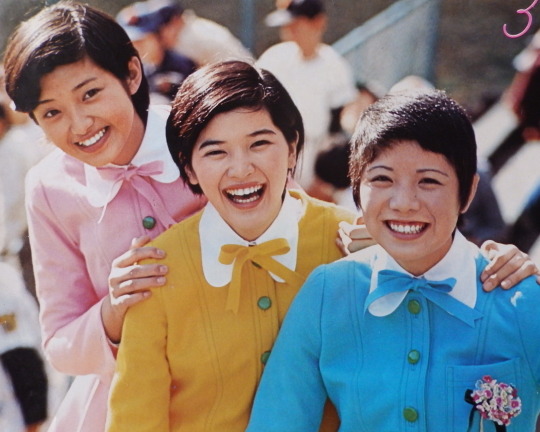
The Hana no Chuushan Trio: Momoe Yamaguchi, Junko Sakurada and Masako Mori.
At 13 years old, Masako Mori secured her place as the inaugural "Star Tanjo" grand champion in 1971. The following year, she debuted under Hori Production and swiftly soared to success. Mori's music was deeply influenced by enka, and by the end of the decade, she had solidified her status as a fully-fledged enka star. In 1986, she tied the knot with enka superstar Shinichi Mori, leading her to retire from the entertainment scene. However, in 2005, following her divorce, the former idol made a comeback, embarking on tours and participating in TV dramas for a few years before ultimately deciding to bid farewell to her career once more on her 60th birthday in 2019. Notably, she shares three children with Shinichi Mori, including TAKA, the lead vocalist of the famous rock band ONE OK ROCK.
Junko Sakurada clinched victory at "Star Tanjo" in 1972 at 14. Subsequently, she signed with Sun Music agency and Victor Music, marking her official debut in February 1973 with the release of "Tenshi mo yumemiru" (Angels Also Have Dreams). Given their similar age, niche, and close debut dates, the industry and some fans pitted her against Momoe Yamaguchi despite their behind-the-scenes friendship. Both idols enjoyed substantial popularity, with Yamaguchi usually holding an edge in sales. The exception was in 1975 when Junpei, as fans affectionately knew her, dominated as the best-selling female idol in music and bromide sales.
In addition to her music career, Junko excelled as an actress. In 1983, she opted to conclude her singing career to dedicate herself solely to acting. A decade later, in 1993, the former idol shocked Japan by announcing her participation in a mass wedding ceremony organized by the controversial South Korean Unification Church at the Olympic Stadium in Seoul. Her husband had been chosen for her by the church.
Her association with the cult brought her career to an abrupt halt. With her image becoming closely linked to the church, TV networks and advertisers distanced themselves from her. Consequently, Junko relocated from Tokyo, devoting herself entirely to her faith and family. Since then, she has made a few comebacks. In 2006, she published a highly-publicized essay book, and in 2013, she celebrated the 40th anniversary of her debut with a special concert. In 2017 and 2018, she returned to the stage, coinciding with her musical comeback and the release of a new album, "My Ideology."
After this project, Junko has remained out of the spotlight, with an official return unlikely unless she completely renounces her ties with the United Church. The cult's controversial image became even more repellent following the murder of former Prime Minister Shinzo Abe in July, committed by a young man who attributed his family's financial and psychological turmoil to the church. Consequently, the cult's unethical financial practices and ties to the ruling Liberal Democratic Party have become widely discussed topics in the country. For Junko Sakurada, her affiliation with the cult has overshadowed her otherwise successful decades-long career.
Completing the trio alongside Junko and Masako was Momoe Yamaguchi. Although Yamaguchi's career has eclipsed that of almost every other idol of the 1970s, she initially experienced the least success among the three young girls. Unlike her peers, both of whom had claimed grand champion titles at "Star Tanjou!," Momoe secured second place at her final showcase. Moreover, her debut single was the poorest-selling among the trio. However, she would ultimately emerge as the definitive idol, and her retirement would serve as the perfect conclusion to an epoch-making career.
While Momoe, Junko, Masako, Mari, Agnes, Rumiko, and Saori, among others, collectively set an impressive precedent for future female idols, male idols also played a significant role in the era. In terms of profitability, male idols reigned supreme, thanks to the unwavering loyalty of their female fanbase.
Johnny Kitagawa, the late founder of Johnny's Jimusho, eventually became the most influential figure in the entertainment industry. He monopolized this niche for decades with his boybands. However, during the 1970s, Kitagawa was just one among many. Although his agency achieved considerable success with the boyband Four Leaves, it was soloist Hiromi Go who briefly held the nation under his sway between 1973 and 1974. Unfortunately for Kitagawa, this period of dominance proved fleeting, as Go departed for another agency in 1976, signaling that Johnny Kitagawa still had much to accomplish to solidify his authority.
With Johnny's domination still on the horizon, Hideki Saijo emerged as the most influential male idol of the 1970s. Saijo enjoyed success with several hit singles, including the ballad "Chigireta Ai," released in 1973, and 1979's "Young Man," a cover of Village People's "Y.M.C.A." Demonstrating the power of devoted fangirls, Saijo became the first domestic solo artist to perform a concert at Nippon Budokan. His popularity quickly transcended the Budokan, propelling him to the status of a stadium headliner and solidifying his position as the decade's top concert ticket seller.
The loyalty of fangirls meant that male idols consistently outperformed any act in ticket sales. In the 1960s, The Tigers, considered one of the pioneers of the "group sound" movement and regarded by many as Japan's first idol group, became the first domestic act to hold a stadium concert. By the following decade, the "group sound" era had ended, but some former band members successfully transitioned into solo careers.
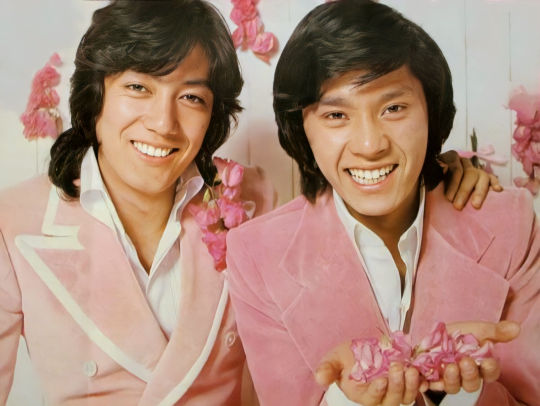
Kenji Sawada and Hideki Saijo, the two stadium-selling male idol superstars from the 80s.
Kenji Sawada, the former lead vocalist of The Tigers, remained a constant presence on the charts throughout the 1970s. Under the guidance of the influential Watanabe Pro agency, Sawada succeeded as a singer and actor. He brought a rockstar aura to his performances, incorporating impactful and extravagant visual elements and pioneering the use of makeup, drawing inspiration from David Bowie and glam rockers. In doing so, Sawada laid the groundwork for visual kei, a movement that would revolutionize Japanese rock in the late 1980s and early 1990s. Nicknamed "Julie" since his early days in the 1960s due to his admiration for Julie Andrews, Sawada continues to thrive as a prominent music figure in Japan, one of the few stars from that era still capable of selling out stadiums.
While girls' adoration often paves the way for male idols to enjoy lengthy careers, there are exceptions to this rule. In 1974, Finger 5 became one of the best-selling idol groups in the country. Comprising five young brothers from Okinawa, they were marketed as Japan's response to the Jackson 5 and consistently churned out hit singles. However, just two years later, their popularity took a nosedive. Several factors contributed to this decline, notably their heavy reliance on the two youngest members, aged only 10 and 12. These youngsters not only grappled with exhaustion from relentless work schedules but also faced the challenges of puberty, causing their voices to change and preventing them from hitting the right notes in their songs. Consequently, Finger 5 lost its appeal.
Finger 5's brief career underscores a crucial aspect of the idol industry: the importance of youthfulness. In Japan's gender-biased society, some male idols from the 1970s were granted the opportunity to age gracefully, evidenced by a few who maintained success well into their 60s and 70s. In contrast, female idols invariably confronted the pressures and inevitable decline associated with aging.
This brings us back to the quintessential idol of that era, Momoe Yamaguchi. By choosing to retire and steadfastly resisting any temptation to reenter the public eye, Yamaguchi effectively became frozen in time at 21 years old, her age at the moment she bid farewell to both showbiz and the public. This solidified her status as a legendary and unattainable icon—an idol who never aged.
70s Japan Trends Through the Music Charts (Part 3)
#enka#kayokyoku#momoe yamaguchi#70s japan#1970s#japanese music#jpop#discover japan#heibon punch#kenji sawada#hideki seiji#junko sakurada#70s idols#finger 5#mari tenchi#rumiko koyanagi#saori minami#four leaves#hiromi go
18 notes
·
View notes
Text
Moving (1993)
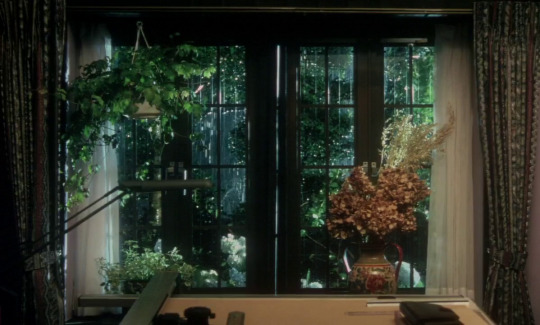


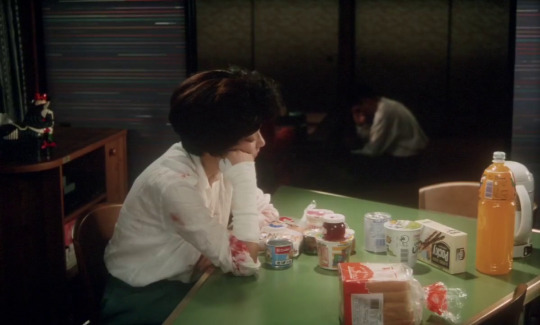




お引越し (Moving, 1993)
directed by Shinji Somai
#movie#movie stills#film#film stills#asian cinema#japanese movie#japanese film#お引越し#moving#tomoko tabata#junko sakurada#kiichi nakai#shinji somai
21 notes
·
View notes
Text
Dans la bibliothèque de... Noissape !
Aujourd’hui, j’inaugure une nouvelle rubrique sur ce blog: celle des « Dans la bibliothèque de… ». Bon, je ne sais pas si je peux parler d’une nouvelle rubrique puisque je n’ai aucune rubrique définie ! Toujours est-il que j’avais envie depuis longtemps de faire des articles croisés avec d’autres blogueurs et blogueuses. C’est l’occasion d’en apprendre un peu plus sur les gens qu’on fréquente sur les réseaux et d’élargir ses propres horizons de lectures. Pour ouvrir le bal, j’ai proposé au plus gros fan de Veil, à savoir Noissape. Il n’y a pas de raison particulière autre que le fait que je devais le voir in real life,et que je savais qu’il marcherait dans ma combine ! N’hésitez pas à le suivre sur les réseaux !
Le premier manga de sa bibliothèque est One Room Angel de Harada. Pré-publié dans le magazine BL onBLUE, l’histoire se concentre sur le personnage de Kôki, trentenaire célibataire précaire. « [Sa] vie, c’est de la merde » jusqu’à ce qu’il rencontre un ange qui décide de s’installer chez lui.

Je dois bien l’avouer, avant de lire One Room Angel, je n’avais qu’un seul souvenir clair de Harada: Piercing Hole, une histoire courte présente dans le recueil Nega. J’avais donc un souvenir de Harada plutôt sexy et violent. One Room Angel est tout le contraire. Grâce au duo mal assorti formé par Kôki et l’Ange, c’est un manga très chaleureux, drôle et qui sait être poignant quand il le faut. C’est aussi une lecture pleine d’espoir où l’autrice s’attache à montrer qu’on fini toujours par rebondir malgré les déceptions, malgré les drames que l’on peut vivre au cours d’une vie. Kôki est un personnage abîmé par la vie, bourré de regrets qui, lorsqu’il rencontre l’Ange, n’a plus aucun espoir ni en la vie ni en lui-même. Grâce aux moments passés avec cet ange, il trouvera en celui-ci une personne à chérir, à aimer. C’est ce sentiment d’amour, qu’il avait perdu depuis longtemps, qui lui permettra de comprendre que la vie vaut la peine d’être vécue. L’Ange quant à lui, lorsqu’il rencontre Kôki, est amnésique. Il ne sait pas pourquoi il est ange ni pourquoi il se retrouve avec Kôki. Il est dans une sorte de purgatoire dont il ne sortira pas tant qu’il ne saura pas les circonstances de sa mort. Grâce à Kôki, il mènera l’enquête jusqu’à trouver la paix. One Room Angel est un très beau manga. Si l’issue ne fait aucun doute, la relation entre Kôki et l’Ange est d’une rare honnêteté. Plus que simples compagnons de galères, Kôki et l’Ange seront salvateurs l’un pour l’autre.
Le second manga de sa bibliothèque est Nonamour de Kyôko Okazaki. Nonamour suit les histoires d’amour ratées de divers personnages, avec comme point de départ le personnage de Junko Sakurada, une jeune fille étudiante en école d’art à la vie trouble. S’en suit le personnage de Santa Hayashiya, étudiant dans la même école d’art se faisant jeter par son amante.
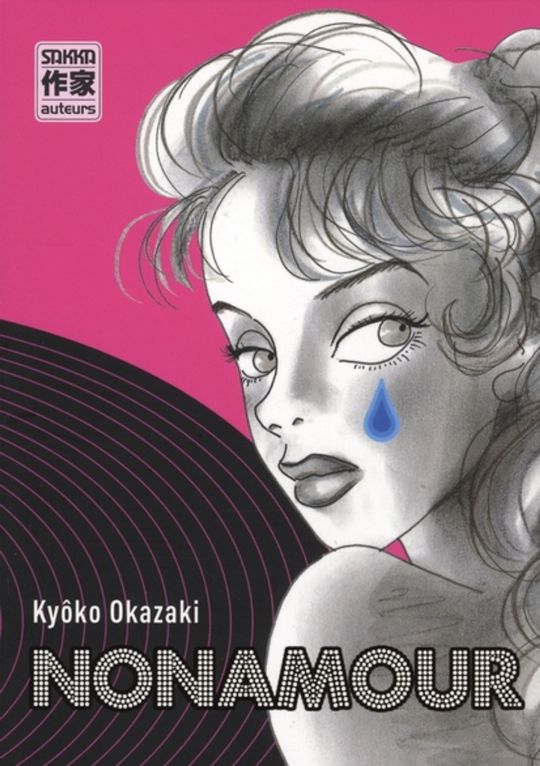
Nonamour, voilà un titre bien énigmatique. Ce n’est pas l’amour, ce n’est pas non plus l’indifférence ou la haine entre deux personnes. C’est n’est pas non plus l’absence d’amour. C’est peut-être plus un amour qui échoue. Les désirs d’aimer et d’être aimé sont bien là, mais comment faire ? Nonamour relate des relations aux aspects divers qui ont toutes le point de commun de ne pas aboutir, faut de savoir-être (ou de savoir-faire ?) en la matière. Oscillant entre moments percutants et moments de légèreté, Nonamour nous plonge dans le quotidien de personnages complètement submergés par leurs propres émotions, rendant leurs relations avec autrui dysfonctionnelles. Chaque personnage est pris dans sa propre tempête d’amour, chacune venant se percuter les unes aux autres. Que les amours soient inavouables, dangereuses, égoïstes, indifférentes ou même inintéressantes, elles ont toutes le point commun d’être des échecs. Quant au dessin de Kyôko Okazaki, personnellement, je l’aime beaucoup. Expressif et très personnel, il fait ressortir avec brio les divers personnages de ce manga. Le découpage maîtrisé aussi bien dans les moments légers que dans ceux poignant permet une immersion dans les émotions et sentiments des personnages. Peut-être plus anecdotique, ou en tout cas moins percutant, que d’autres titres de l’autrice, Nonamour n’en reste pas moins un manga brillant dans sa manière de dépeindre les affres de l’amour.
Le dernier de sa bibliothèque est Litchi Hikari Club de Usamaru Furuya. Pré-publié dans le feu magazine à l’ambiance underground Manga Erotics F, le manga relate l’histoire d’une bande de copains formant le Hikari Club. Plutôt qu’un club au climat bon-enfant, c’est plutôt une société secrète voire une secte avec comme leader suprême Zéra. Leur but ? Créer un monstre mécanique carburant aux litchis capable d’enlever des filles.
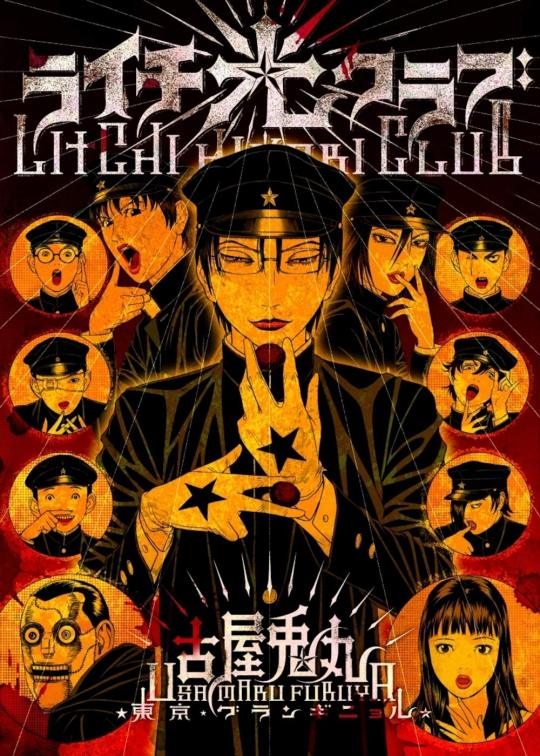
D’Usamaru Furuya je n’ai lu que Short Cuts que j’adore et Je voudrais être tué par une lycéenne que j’avais trouvé sans grand intérêt. Leur point commun reste le côté grotesque. Litchi Hikari Club n’échappe pas à ce caractère grotesque puisque c’est un manga dit ero-guro (pour « érotique » et « grotesque »). C’est l’adaptation en manga de la pièce de théâtre du même nom, imaginé et joué par la compagnie Tokyo Grand Guignol durant les années 80, élément incontournable de la culture angura. Il est difficile d’écrire quoi que ce soit tant le terme ero-guro est explicite. Litchi Hikari Club est un manga à l’ambiance malsaine, transpirant les hormones en feu de l’adolescence avec une bonne dose de passages gore. Pourtant, c’est délicieux, la maestria du mangaka opérant. Si je n’ai pas grand-chose à dire sur le côté ero-guro, je peux tout de même dire que j’ai particulièrement aimé le personnage de Litchi, « l’élégante machine » a enlever les filles. Aux côtés de Kanon, il m’a même ému. Finalement, c’est peut-être le plus humain parmi ces humains. J’ai aussi beaucoup aimé comment Furuya fait ressortir le côté grotesque de la majeure partie du récit en plaçant quelques éléments de celui-ci dans le réel. Ces collégiens vont à l’école avec leurs véritables noms, ils ont des familles, et ils sont bel et bien mortels. Plus que d’être un incontournable du manga ero-guro, Litchi Hikari Club est un incontournable du manga tout court tant il représente une extrémité de la diversité du média.
Le mot de la fin
C’était donc le tout premier article de cette nouvelle rubrique « Dans la bibliothèque de… » ! Je ne sais pas quand sera le prochain article dans la rubrique ni avec qui, mais comptez sur moi pour remettre ça !! Merci de m’avoir lu jusqu’ici, et comme d’habitude, si vous avez aimé cet article, n’hésitez pas à le partager autour de vous ! On se retrouve sur Twitter, ko-fi et Anilist. Des bisous.
11 notes
·
View notes
Video
youtube
Japanese City Pop on vinyl with Shaqdi
00:11 Kumiko Hara-Paradise
04:21 Nina Atsuko-Icebox & Movie
08:06 Junko Sakurada-わたしの広告
12:00 Mai Yamane-Ta So Ga Re
17:10 Mariya Takeuchi-Oh No, Oh Yes
21:20 Anri-Dancin’ Blue
24:33 Noriko Miyamoto-熱\風
28:12 Hitomi Tohyama-Tuxedo Connection
31:15 Anri-Windy Summer
35:06 Tatsuro Yamashita-Melody Kimi No Tameni
39:19 Ruriko Ohgami-Fuwarifuwafuwa
via My Analog Journal / Shaqdi
9 notes
·
View notes
Text
Disintegration! The reality of a Japanese UC ‘blessed couple’.
May 15, 2014
[ A true story ]
Nice to meet you, I am an active member of the Unification Church.
I was blessed at the 30,000 Mass Wedding [in Korea on August 25, 1992] at the same time as Sakurada Junko. From the beginning of our marriage there was no feeling for each other, and more than 30 years have now passed.
Without emotion, or preference or love for each other, we got married as our parents and Church leaders told us. Up to now we have three children.
Now I am over 50 years old
… When I look back over the half of my life which has passed,
… I have only lived following the wishes of my parents.
… Who am I?
… Why was I born?
… As a person, was I able to contribute something to this world?
… What can I leave for my children?
… Now I am without friends, and without money.
… I have only a large debt.
… Our eldest son ran away from home after he graduated from Junior High School. We have not heard from him since.
… Our eldest daughter was 'blessed’ with a Korean man,
but she returned home one year later.
… Our second son was bullied and became a Hikikomori
– a recluse at home.
… My wife (even though she has no money) still makes frequent visits to Cheongpyeong.
… This is the reality of our home after we received the 'blessing’.
Now, in my fifties, I have new thoughts and feelings
… I have finally made a move to divorce my wife.
… 90 percent of the debt on our home was made by my wife.
… I have also sold my wife’s home and land, worth several hundred million yen.
… My wife donated all the inheritance from my parents as well (several tens of million yen).
… I cannot take it anymore.
Fuck you, Unification Church! Give me back my life!
…
_____________________________________________
I am a 2nd gen of the Unification Church in Japan
July 2, 2014 Unification Church News
I am a second generation of members of the Unification Church [in Japan. My parents joined.]
I clashed with my parents so many times. Finally I was able to get out of the house!
I feel as though I were liberated from the Unification Church! (strangely)
My parents are over 60, but they are still getting into more debt to make donations to the church! Every month a woman director of the church comes to urge my parents to give more donations.
They have no pension, no life insurance, and of course they have no savings.
Somehow my parents’ lives are just too pathetic! I do not want to be like that.
My parents are fucking earnest, and very kind… They gave birth to me, they brought me up… I feel gratitude, but I cannot keep this up anymore.
Dad, Mom, you are getting older, before you suffer from sickness or from your debts… please pass away peacefully.
You have already donated to the Unification Church, the fee for my school trip and my lunch expenses…
…To my parents
Tokyo Metropolitan area
http://ameblo.jp/w-kazoku/entry-11887859609.html
_____________________________________________
Japanese Unification Church member beaten by several men who were unhappy with her tithing
_____________________________________________
http://ameblo.jp/w-kazoku/entry-11850259152.html
・・・とある、現役の食口からのメッセージ
テーマ:統一教 NEWS 2014年05月15日
【実話】崩壊! 祝福家庭の実態
・・・とある、現役の食口からのメッセージ
はじめまして、私は現役の統一教会信徒です。
桜田淳子さんと同じ三万双の祝福を受けましたが、結婚当初からお互いの気持ちが通じることもなく30年以上もの月日が流れてしまいました。
お互い、好きとか愛しているとかといった感情も無く、親や教会長らの言うがままに結婚し、3人の子供を授かり現在に至っております。
50も過ぎ
・・・今までの半生を振り返ってみれば
・・・親の言いなりに生きてきただけ
・・・自分は何だったのか?
・・・何のために生まれてきたのか?
・・・子どもたちに何を残せたのか?
・・・人として、この世に何か貢献できたのか?
・・・友達も無く、お金もなく
・・・今あるのは、多額の「借金」だけ
・・・長男は中学を卒業した時に家出をして音信不通
・・・長女は韓国人と祝福を受けたが1年もたたないうちに帰国
・・・次男は「いじめ」を受けて引きこもり
・・・妻は、(金もないのに)チョンピョンに通い詰め
・・・これが、祝福を受けた我が家の現実です。
まだ、50代と気持ちを新たに
・・・妻と離婚しようと、重い腰をあげました
・・・我が家の借金の九割は妻が作ったものです。
・・・妻の実家の家や土地までも売ってしまいました。
・・・数億円
・・・私の親の遺産(数千万円)も妻が全て献金してしまいました。
・・・もう我慢できません
くたばれ、統一教会! 俺の人生を返せ!
・・・。
1 note
·
View note
Note
Music! (Round 2: Electric Boogaloo!)
Get Back by Orla Gartland
気まぐれヴィーナス by Junko Sakurada
Inconvenience Store by Louie Zong
girls just wanna have sex by mazie
The 5 minute mythology by UK Rampage
1 note
·
View note
Text
Junko Sakurada - サンタモニカの風 (7", Single)
Junko Sakurada – サンタモニカの風 (7″, Single)
Vinyl(VG+) Sleeve(VG+) /
コンディション 盤 : Very Good Plus (VG+)
コンディション ジャケット : Very Good Plus (VG+)
コンディションの表記について [ M > M- > VG+ > VG > G+ > G > F > P ]
レーベル : Victor – SV-6552
フォーマット : Vinyl, 7″, 45 RPM, Single
生産国 : Japan
発売年 : 1979
ジャンル : Pop
スタイル :
収録曲 :
A. サンタモニカの風 B. 昼下がりのエレジー
Data provided by Discogs
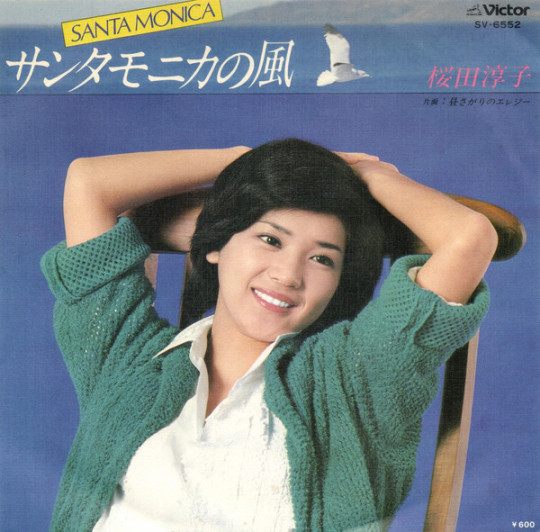
View On WordPress
0 notes
Text
Témoignages d'ex adeptes de l'Eglise de la Réunification (1)
Comme l'Eglise de la Réunification côté Coréen ne prévoit pas de parcours de "don de soi", certains membres en Corée boivent toujours de l'alcool ou ont des relations amoureuses hors mariage.
1er témoignage : le mensonge des mariages collectifs internationaux.
Cette partie de ma vie où la “bénédiction” était le carburant de mon dévouement.
“En retombant sur les images du mariage collectif de 1988 à la télévision, j’ai été pris par un fort sentiment d’amertume.L’Eglise de la Réunification est en train de tenter de se servir de l’image de Junko Sakurada et de Hiroko Yamazaki pour…
View On WordPress
0 notes
Text
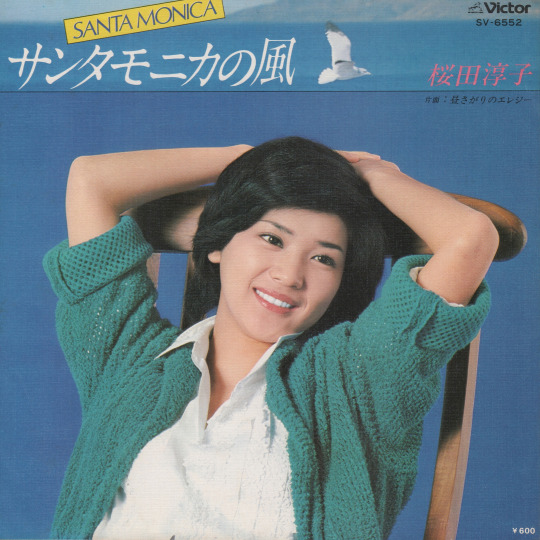
Artist - 桜田淳子 (Sakurada, Junko)
Song - サンタモニカの風 (Santa Monica No Kaze)
[Eng. "The Wind Of Santa Monica"]
Release Date - February 1979
Listen 🎶
My blog: Showa Music Library
https://nobbykun.tumblr.com/
2 notes
·
View notes
Photo
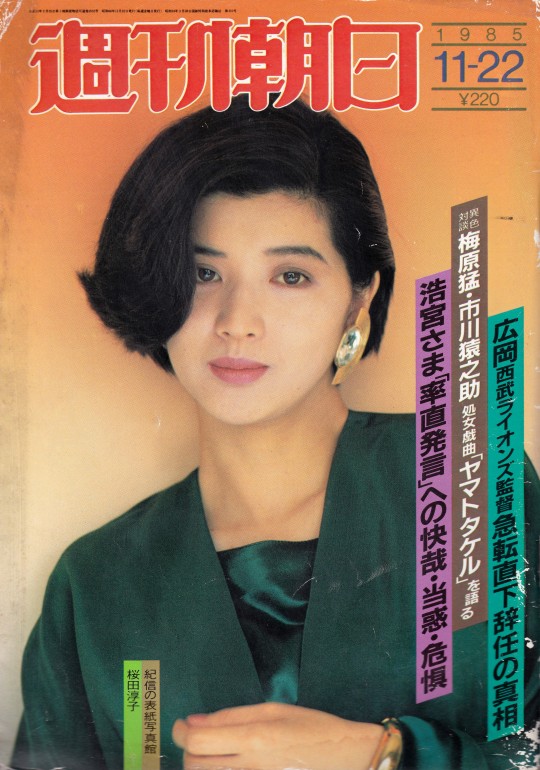
週刊朝日 1985年11月22日号
朝日新聞社
紀信の表紙写真館=桜田淳子
80 notes
·
View notes
